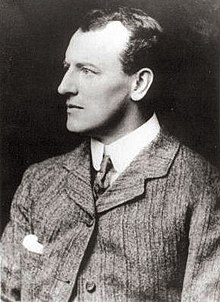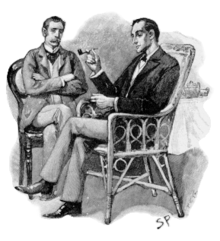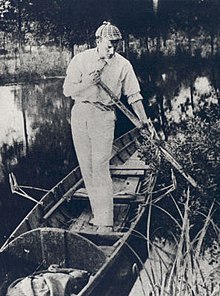Sidney Paget

Sidney Edward Paget ( /ˈpæ[invalid input: 'J']it/)[1] (4 October 1860 – 28 January 1908) was a British illustrator of the Victorian era, best known for his illustrations that accompanied Arthur Conan Doyle's Sherlock Holmes stories in The Strand magazine.
Life
Sidney Paget was the fifth of nine children born to Robert Paget, the vestry clerk of St. James and St. John in Clerkenwell and Martha Paget (née Clarke), a music professor. In 1881 Paget entered the Royal Academy Schools. Here he befriended Alfred Morris Butler, an architecture student who may have become the model for Paget's illustrations of Dr. John Watson. Between 1879 and 1905, Paget contributed eighteen miscellaneous paintings, including nine portraits, to the Royal Academy exhibitions.
Paget's drawings appeared in the Strand Magazine, the Pictorial World, The Sphere, The Graphic, the Illustrated London News, and the Pall Mall Magazine, and his work became well known in both the United Kingdom and United States. He provided illustrations for Arthur Morrison's Martin Hewitt detective stories, and Arthur Conan Doyle's Sherlock Holmes work, doing much to popularise both series.
On 1 June 1893, Sidney Paget married Edith Hounsfield (born 1865), daughter of William Hounsfield, a farmer. They had four daughters and two sons together; Leslie Robert (1894); Winifred (1896); Edith Muriel (1897); Evelyn Mereoah (1899); Beryl May (1902) and John L. Paget. Sidney Paget died in Margate on 28 January 1908, after suffering from a painful chest complaint for the last few years of his life. According to his death certificate, the cause of Sidney Paget's death was "Mediastinal tumour, 3 years, exhaustion." Mediastinal tumors are growths that form in the middle of the chest area which separates the lungs. As the tumor grows, the patient's breathing becomes more and more constricted. It's a rare condition and, in the early 1900s, it was a painful and certain death sentence. Then and now, no known causes exist, and there are no known links between the condition and any substance.
Paget was buried in East Finchley Cemetery. Two brothers, H.M. (Henry Marriott) Paget (1856–1936) and Wal (Walter Stanley) Paget (1863–1935) were also successful portraitists and illustrators.[2]
The Strand illustrations


Today, Sidney Paget is best known as the creator of the popular image of Sherlock Holmes from the original publication of Conan Doyle's stories in the Strand Magazine. He was inadvertently hired to illustrate The Adventures of Sherlock Holmes, a series of twelve short stories that ran from July 1891 through December 1892, when the publishers accidentally sent him the letter of commission rather than his younger brother, Walter Paget.
Despite the commonly held belief that Paget based Holmes' appearance on that of Walter, his brother Henry Marriott (H.M.) Paget denied this was the case. "The assertion that the artist's brother Walter, or any other person, served as model for the portrait of Sherlock Holmes is incorrect."[3]
In 1893, Paget illustrated The Memoirs of Sherlock Holmes, published in The Strand as further episodes of the Adventures. When Sir Arthur Conan Doyle revived the Sherlock Holmes series with The Hound of the Baskervilles, serialised in The Strand in 1901–02, he specifically requested that Paget be the illustrator. Paget went on to illustrate another short story series, The Return of Sherlock Holmes, in 1903–04. In all, he illustrated one Holmes novel and 37 Holmes short stories. His illustrations have influenced interpretations of the detective in fiction, film and drama.

The Strand became one of Great Britain's most prestigious fiction magazines, with the Holmes series its most popular feature. As Holmes' popularity grew, Paget's illustrations became larger and more elaborate. Beginning with "The Adventure of the Final Problem" in 1893, almost every Holmes story in the The Strand featured a full-page illustration as well as many smaller pictures within the text. The illustrations also gained a darker tone as Paget used the black-and-white medium to reflect the grim mood of the stories. The deep, shadowy look of Paget's illustrations was a probable influence on American detective movies and film noir and has had a profound influence on every film version of the Holmes stories.
Paget is also credited with giving the first deerstalker cap and Inverness cape to Holmes, details that were never mentioned in Arthur Conan Doyle's writing. The cap and coat first appear in an illustration for "The Boscombe Valley Mystery" in 1891 and reappear in "The Adventure of Silver Blaze" in 1893. They also appear in a few illustrations from The Return of Sherlock Holmes. (The curved calabash pipe was added by the stage actor William Gillette; see, Smoking pipe (tobacco)#Calabash.)
Altogether, Sidney Paget did some 356 published drawings for the Sherlock Holmes series. After his death in 1908, other illustrators found that they had to imitate Paget's style when drawing Sherlock Holmes. The Paget illustrations have been reprinted in many Holmes anthologies and have become iconic in depicting the fictional character.
A complete set of Strand issues featuring the illustrated Sherlock Holmes tales is one of the rarest and most expensive collector's items in publishing history. Paget's original 10.5 x 6.75-inch drawing of "Holmes and Moriarty in Mortal Combat at the Edge of the Reichenbach Falls" was sold by Sotheby's in New York on 16 November 2004 for $220,800.
The two-handed clasp that Paget shows Holmes using on Moriarty in the illustration was used by Holmes for the same scene in the 2011 film Sherlock Holmes: A Game of Shadows, though the specific description of the fight is never actually mentioned in the book.
Notes and references
- ^ Jones, Daniel; Gimson, Alfred C. (1977) [1917]. Everyman's English Pronunciation Dictionary. Everyman's Reference Library (14 ed.). London: J. M. Dent & Sons. ISBN 0-460-03029-9.
- ^ http://www3.westminster.gov.uk/docstores/publications_store/holmes_portraits.pdf
- ^ Oxford Dictionary of National Biography, 1912
